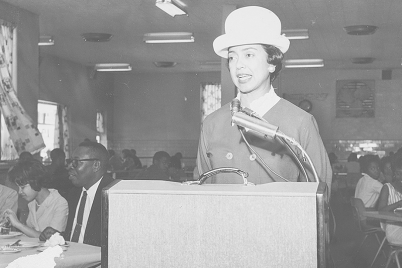Marion Lois Jones, former world-champion track and field athlete [Photo: Rick Sforza, U.S. Air Force]
BY KEISHA BELL | Visionary Brief
Sometimes, other people see the possibility of your greatness before you see it yourself. Even in situations when you know that you are terrific at something, it may take time to visualize how great you can become. Without a proper support team to assist in steering you away from danger amid the applause, you may unknowingly fall victim to it.
Meet Marion Lois Jones, formerly a world-champion track and field athlete. Jones also played professional basketball for a brief period. She was born in Los Angeles on Oct. 12, 1975, and graduated from the University of North Carolina (UNC) in 1997.
Before college, Jones established herself as “an athlete to watch” in both track and basketball. As a high school track star, she won the CIF California State Meet in the 100-meter sprint four years in a row.
Jones was also selected the Gatorade Player of the Year for track and field three years in a row. Not surprisingly, in 1991 and 1992, she became the third female athlete to be named the High School Athlete of the Year by Track and Field News twice.
With so many accolades in track and field, Jones arrived at UNC on a full scholarship in basketball. After helping her university’s basketball team win the NCAA championship as a freshman, Jones “redshirted” her 1996 basketball season to concentrate on track. Of the two sports, she decided to pursue a career in track and field.
It did not take long for Jones to find success as a professional in track. She won the 100-meter sprint at her first international major competition in 1997. Two years later, she won that event again at the same tournament, as well as a bronze in the long jump.
At the 2000 Olympics, Jones won three gold medals and two bronze medals. She was later stripped, however, of these Olympic medals after admitting that she had used performance-enhancing drugs.
Rumors of Jones using drugs to improve her track and field results surrounded her even as an amateur. While in high school, she faced charges of doping. At that time, she was successfully defended by attorney Johnnie Cochran on the charges.
On the Olympic stage, however, she was one of the more popular athletes linked to the BALCO drug scandal. The rumors of drug usage followed Jones throughout two Olympiads. She did not help her image by training with both coaches and athletes who were also surrounded by rumors and accusations of using performance-enhancing drugs.
In 2007, Jones admitted to using drugs to enhance her performance. Many of her fans were disappointed.
Track and field had been kind to Jones. She was one of track’s first female sports millionaires. It was routine for Jones to earn between $70,000 and $80,000 a race. Also, Jones would typically earn at least an additional $1 million from race bonuses and endorsement deals.
The events that followed her confession changed her life drastically. She retired from the sport, returned the Olympic medals, suffered significant financial loss, faced public and private shame and received a jail sentence.
After her incarceration, Jones wrote her autobiography in which she shares many lessons. She has also traveled the country, giving speeches and sharing her story. Even amid the drug-enhancement rumors, Jones was still beloved by millions of fans.
Many still wonder what would have been if Jones had a support system that would have helped to direct her away from danger. In a sport that rewards speed, would Jones be in the record books if someone slowed down long enough to look closer at the temptations? She was coached to win, but what if she was mentored to last?








